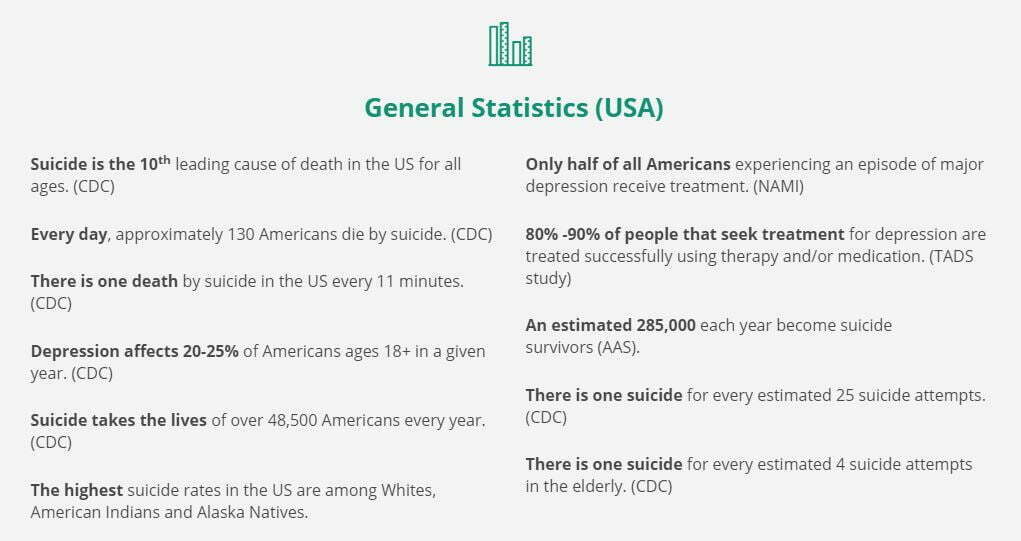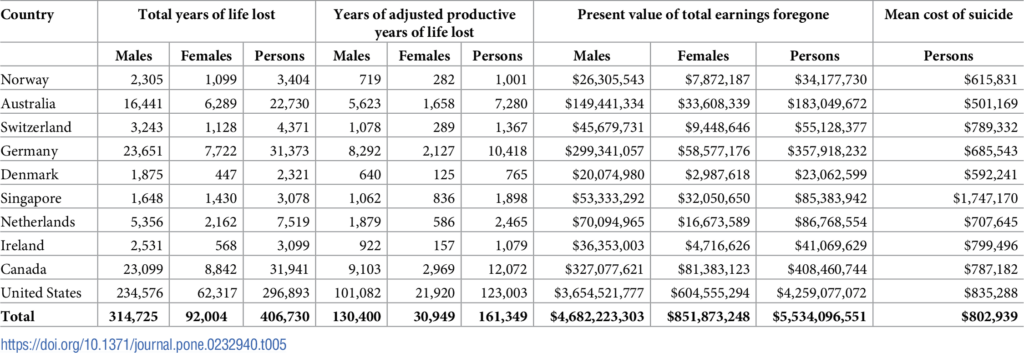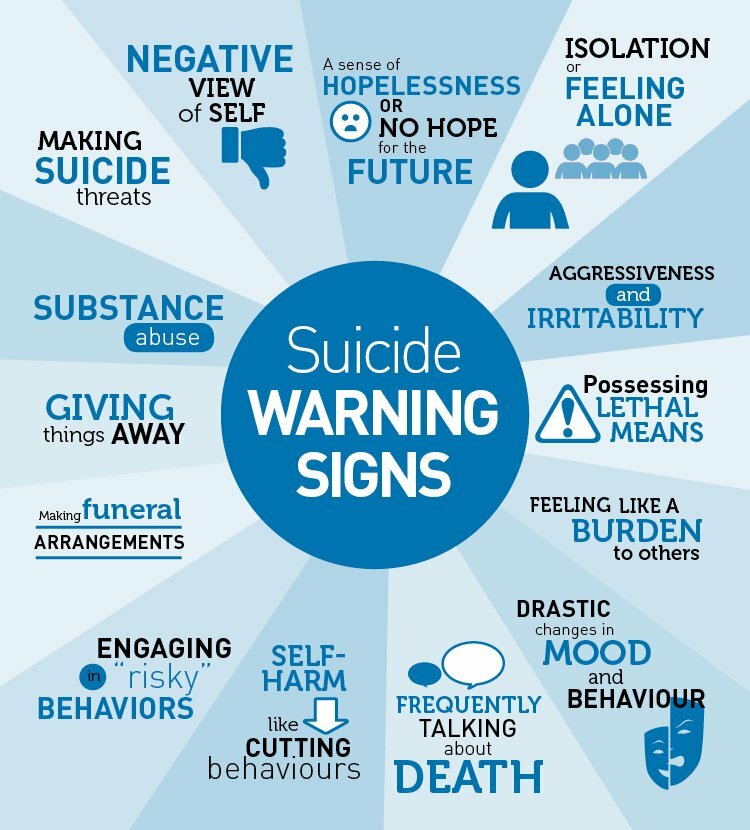The report noted that in 20 years (2000-2019), the global suicide rate had decreased by 36 percent. The decrease ranged from 17 per cent in the Eastern Mediterranean Region to 47 per cent in the European Region and 49 per cent in the Western Pacific Region.
Warning signs that someone may be at immediate risk for attempting suicide include: talking about wanting to die or wanting to kill themselves; talking about feeling empty or hopeless or having no reason to live; talking about feeling trapped or feeling that there are no solutions; feeling unbearable emotional or physical pain; talking about being a burden to others; withdrawing from family and friends; giving away important possessions; saying goodbye to friends and family; putting affairs in order, such as making a will; taking great risks that could lead to death, such as driving extremely fast; talking or thinking about death often.
Other serious warning signs that someone may be at risk for attempting suicide include: Displaying extreme mood swings, suddenly changing from very sad to very calm or happy; Making a plan or looking for ways to kill themselves, such as searching for lethal methods online, stockpiling pills, or buying a gun; Talking about feeling great guilt or shame; Using alcohol or drugs more often; Acting anxious or agitated; Changing eating or sleeping habits; Showing rage or talking about seeking revenge.
Among young people aged 15-29, suicide was the fourth leading cause of death after road injury, tuberculosis and interpersonal violence, according to the study: Suicide worldwide in 2019. While rates varied between countries, regions and gender, the analysis shows that more than twice as many men kill themselves, than women. Those rates are generally greater in high-income countries, while the highest suicide rates for women were found in lower middle-income countries. Per 100,000 people, the 2019 global average of suicide rates stood at 9.0, while that number jumped to 11.2 in the WHO Africa region; 10.5 in Europe; and 10.2 in Southeast Asia. At 6.4, the Eastern Mediterranean region had the lowest rate.
Suicides among young people continue to be a serious problem. Suicide is the second leading cause of death for children, adolescents, and young adults age 15-to-24-year-olds. The majority of children and adolescents who attempt suicide have a significant mental health disorder, usually depression. Among younger children, suicide attempts are often impulsive. They may be associated with feelings of sadness, confusion, anger, or problems with attention and hyperactivity. Among teenagers, suicide attempts may be associated with feelings of stress, self-doubt, pressure to succeed, financial uncertainty, disappointment, and loss. For some teens, suicide may appear to be a solution to their problems.

Depression and suicidal feelings are treatable mental disorders. The child or adolescent needs to have his or her illness recognized and diagnosed, and appropriately treated with a comprehensive treatment plan.
According to the Centers for Disease Control and Prevention (CDC), women are more likely to attempt suicide than men, but men are more likely to die by suicide than women. This may be because men are more likely to attempt suicide using very lethal methods, such as firearm or suffocation (e.g., hanging), and women are more likely to attempt suicide by poisoning, including overdosing on prescribed or unprescribed prescription drugs. However, recent CDC data suggest that the leading means of suicide for women may be shifting toward more lethal methods.
CDC data also show that suicide rates vary by race, ethnicity, age, and gender. American Indian and Alaska Native men have the highest rates of suicide, followed by non-Hispanic White males. Although the rate of suicide death among preteens and younger teens is lower than that of older adolescents and adults, it has increased over time. Suicide now ranks as the second leading cause of death for youth ages 10 to 14. For children under age 12, research indicates that Black children have a higher rate of suicide death than White children.

The number of people worldwide who die from suicide is declining but one person still kills themselves every 40 seconds, according to new figures from the World Health Organization, which said countries needed to do more to stop these preventable deaths. (CNN)
Although the economic situation significantly affects the number of suicides, it works the opposite direction as well. In addition to the emotional value, every extinguished life also means an economic loss. The table below shows the epidemiological and economic impact of youth suicide in the ten countries with the highest human development index, a statistical composite index of life expectancy, education, and per capita income indicators and etc. Secondary analysis of suicide mortality data for youth aged between 15–24 years are used to produce the figures above. The impact of youth suicide is measured using years of life lost, years of productive life lost and present economic value of lost productivity.

Poverty and mental health as a key factor
Professor Eric Elborgen from Duke University found that people experiencing financial stressors including homelessness, debt, low income face a 20 times higher risk of committing suicide. To put it into perspective, in 2018, approximately 420,000 people experiencing problem debt in the UK has admitted to having suicidal intentions while 100,000 of them actually committed suicide.
While financial difficulty has been proven to be a significant cause of mental health issues, it also works in the opposite direction. People with mental health problems are more likely to experience financial difficulties and therefore also face a significant risk of committing suicide. Globally about one in seven people experience mental health problems. Studies have also found that people with existing mental health problems are 3.5 times more likely to face problem debt, not to mention a staggering 44% of adults in the UK who fell behind on bills during the pandemic and have either attempted or considered taking their own life.
When it comes to managing personal finances, millions with mental health issues struggle to liaise with essential serving companies such as banks, telecommunications or energy companies. Over 50% of people with mental health issues reported difficulties with contacting essential service companies, 22% of them reported panic attacks due to the complexity and bureaucracy faced when liaising with these companies. “We all have hassles when trying to call up essential servicing firms, but what’s inconvenient for most of us could be a major life detriment to someone with mental health conditions,” said Martin Lewis, the founder of Money and Mental Health Policy Institute. “In the long run, the best way to break the connection between financial difficulty, mental health issues and suicide is to eradicate financial hardship,” as quoted in a report by Nikki Bond and Meryln Holkar, both a researcher at the institute.

Identification and prevention
The key is to identify early those who are at risk of committing financial suicide. Since more than half of the population do not communicate their finances with friends or family, essential servicing companies or creditors are the only parties who have the knowledge of one’s financial situation. And sometimes it is the only possible source of help. Therefore, it is important that these companies implement measures to identify those who are at risk of financial suicide in their database.
Employee suicide prevention training will also help the identification process as staff will be able to take note of customers with suicidal intentions and refer them to support or counselling services. Through this training, they can also learn how to communicate with people who have suicidal thoughts or mental illness so they feel less stressful when dealing with their bills and finances. This staff knowledge can further extend into reframing and rephrasing company websites as well as standardized letters to minimize the stress level of potential perpetrators of suicide.
Lloyds Bank (UK) is one of the very few essential servicing companies which have taken the efforts to reduce customer stress levels in their processes and to become more accessible to people with mental health problems. For more companies to join Lloyds Bank in realizing this initiative, concerted efforts by various governmental and non-governmental authorities are essential to raise awareness, gather investments and lobby for change. In light of the importance of authorities in realizing efforts to break the link between financial difficulty, mental health issues and financial suicide, more research need to be done to help organizations identify financial difficulty and risk of suicide. Stigma associated with mental health problems also needs to be actively countered especially in developing nations so that the issue of financial suicide can earn its place in the public’s eye.
This article was created as part of the TeaMWork program that brings together students across the globe (Monash University in Australia and Malaysia, and the University of Warwick in the United Kingdom).
Co-author: Ming Yee Chan, Monash University Malaysia



